Latest posts by (see all)
- The Best Things to Do in Tulsa - June 26, 2020
- The Most Interesting Things to Do in Springfield Mo - June 15, 2020
- Best Things to Do in Salt Lake City - May 26, 2020
- 10 Best Websites for Playing Online Games - May 22, 2020
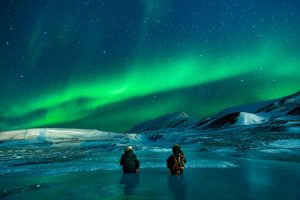 Snow-capped mountains, endless forests, animals in their habitat. Alaska is nature in its purest form.Alaska, located on the northwestern outskirts of North America, is a protected area with extraordinary beauty of river valleys, forests and glaciers. The nature of Alaska in many places is preserved in its original form, which attracts tourists. It received its name from the Aleutian word meaning “a place where there are many whales”.
Snow-capped mountains, endless forests, animals in their habitat. Alaska is nature in its purest form.Alaska, located on the northwestern outskirts of North America, is a protected area with extraordinary beauty of river valleys, forests and glaciers. The nature of Alaska in many places is preserved in its original form, which attracts tourists. It received its name from the Aleutian word meaning “a place where there are many whales”.
Although, it is physically separated from the rest of the United States, Alaska is one of the most picturesque and fascinating states in America. The remoteness of this territory only adds to the beauty and mystery of the 49th state, which makes Alaska an attractive holiday destination for lovers of extreme travel and nature. Along with major cities like Anchorage, natural monuments and landmarks make Alaska so interesting. Make a virtual tour around Alaska now and you’ll see that it’s worth seeing in real life.
Contents
- Thing to do number 1: Visit Kenai Fjords National Park
- Thing to do number 2: Go to Katmai National Park
- Thing to do number 3: Go to the Wrangell St. Elias National Park and Preserve
- Thing to do number 4: Visit the Museum of the North
- Thing to do number 5: Swim in the China Hot Springs
- Thing to do number 6: Go to the Skagway
- Thing to do number 7: Visit the Cruise Port of Ketchikan – “Salmon Capital of the World”
- Thing to do number 8: Go to the Resurrection Bay
- Thing to do number 9: Have a Look at the Great Landscapes of the Kobuk Valley
- Thing to do number 10: Try your luck looking for gold on the banks of Nome
- Video
Thing to do number 1: Visit Kenai Fjords National Park
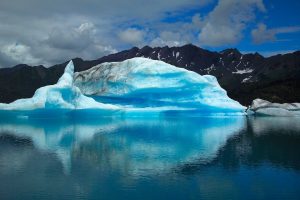 Visit of the Kenai Fjords National Park is like a step back during the Ice Age. Glaciers and ice caps still exist and leave vivid and unforgettable impressions on tourists. Half of the park is covered with ice all year round, which has formed real fjords over the years. These fjords are an ideal habitat for many representatives of aquatic fauna, migrating whales, birds.The park has existed since 1980 and was created in order to protect the Arctic territories from the negative influence of humans. The three major natural attractions in Park Three are the Vanishing Glacier, Harding Ice Field, and the coast. Why should you visit this place? There are many reasons for this:
Visit of the Kenai Fjords National Park is like a step back during the Ice Age. Glaciers and ice caps still exist and leave vivid and unforgettable impressions on tourists. Half of the park is covered with ice all year round, which has formed real fjords over the years. These fjords are an ideal habitat for many representatives of aquatic fauna, migrating whales, birds.The park has existed since 1980 and was created in order to protect the Arctic territories from the negative influence of humans. The three major natural attractions in Park Three are the Vanishing Glacier, Harding Ice Field, and the coast. Why should you visit this place? There are many reasons for this:
- Lovers of wildlife recreation can see mountain ravines, glaciers, avalanches, gulfs and icebergs here. The inhabitants of the park – polar bears, seals, walruses, whales, the coastal zone is rich in exotic marine flora.
- Ice cruises are organized from the town of Seward – a 6-hour journey along the Kenai Fjord, where you can see with your own eyes how huge ice blocks break off from icebergs and fall into the sea.
- While visiting Kenai Fjords Park, tourists can visit the Alaskan National Marine Reserve – one of the most famous in the United States. This giant reserve is spread over 1.8 million hectares and covers most of the islands of the Aleutian Ridge.
Interesting: The total area of the park is 2833 square kilometers, 60 percent of which are covered with snow and ice.
Thing to do number 2: Go to Katmai National Park
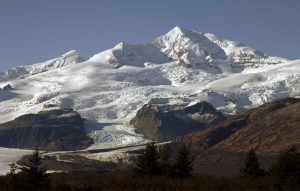 The national park occupies the entire coastline of the Shelikhov Strait, the Aleutian Peninsula and part of the territory located north of Lake Nanek.
The national park occupies the entire coastline of the Shelikhov Strait, the Aleutian Peninsula and part of the territory located north of Lake Nanek.
- The main character of the reserve is a majestic active volcano, on the left slope of which there is a glacier.
- The height of the volcano is more than 2000 meters, and its diameter is 10 km.
- During the last and strongest eruption in 1912, a volcanic lake with muddy-green water was formed. The same eruption destroyed the pine forest on the western slope of the volcano, turning it into a valley of thousands of smoke, which is a fountain of red-hot steam and gases.
Interesting: The Brooks River annually attracts tourists who dream of seeing the exciting and fascinating spectacle of fishing with brown bears. Alaska is home to the largest population of these animals in the world.
Thing to do number 3: Go to the Wrangell St. Elias National Park and Preserve
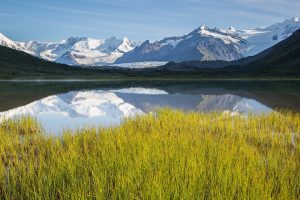 Wrangel St. Elias National Park is on the UNESCO list of cultural heritage sites and is a unique natural monument. It is the largest national park in the United States.
Wrangel St. Elias National Park is on the UNESCO list of cultural heritage sites and is a unique natural monument. It is the largest national park in the United States.
- The main value of the park is the majestic millennial glaciers and ice fields, which occupy almost one-fourth of the area of the entire park and freeze to a depth of more than 900 m. In summer, due to the fact that the glaciers begin to melt, water flows into the rivers. The area of the largest glacier is about 819 square km.
- Another amazing attraction is the Wrangel Mountains. This is a high-mountain volcanic massif, the length of which totals almost 150 km, consisting of the active Wrangel volcano and two extinct volcanoes. It is here that the mountain of St. Elias is more than 5 thousand meters high – the second peak after Mount McKinley.
As for recreation, the Wrangel Park and St. Elias is just perfect for hiking and trekking, as well as small flights by air taxi.
Interesting: If you are licensed by the state of Alaska and subject to strict state law in the park, you can engage in fishing and hunting. If you prefer hunting, then professional hunter-guides will help you.
Thing to do number 4: Visit the Museum of the North
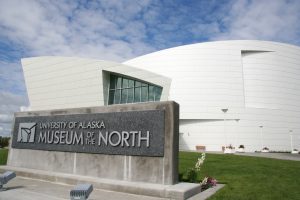 Located in the unique futuristic building of the Museum of the North of the University of Alaska offers its visitors a lot of interesting exhibits.
Located in the unique futuristic building of the Museum of the North of the University of Alaska offers its visitors a lot of interesting exhibits.
- The largest number of exhibits is presented in the cultural, geographical and historical halls.
- Among the most interesting exhibits are Inuit products, as well as a real ice age mummy of the Ice Age.
- Particular attention is paid to the indigenous peoples of Alaska – among the exhibits are their traditional costumes.
In addition to the main halls, which vividly demonstrate the peculiarities of the local nature, the Museum of the North has a Rose Berry gallery, where Alaska artists canvases are exhibited.
Interesting: Attention should also be paid to the Georgeson Botanical Garden and the “Station for the Study of Large Animals”.
Thing to do number 5: Swim in the China Hot Springs
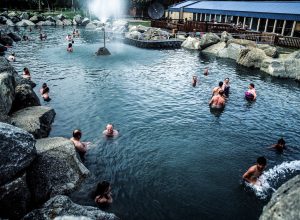 China Hot Springs is a small town located in the Fairbanks-North Star, Alaska.
China Hot Springs is a small town located in the Fairbanks-North Star, Alaska.
- The settlement is located one hundred kilometers northeast of the city of Fairbanks. In August 1905, a hot spring was found here by Robert Swan.
- The water in it turned out to be very close in properties to the Carlsbad spring.
The hot spring quickly gained popularity among tourists, and soon a resort was built here. The resort gave the village of Chin Hot Springs a new breath: every year, it is visited by a huge number of tourists who want to swim in hot water.
Interesting: With the help of the hot spring, many of the systems necessary for the life of the settlement were also established: a low-temperature geothermal power station and heated greenhouses.
Thing to do number 6: Go to the Skagway
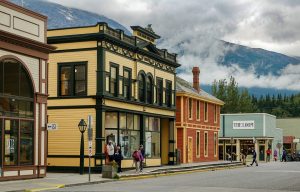 Skagway is a small settlement in southeastern Alaska that was founded during the gold rush and is now a popular tourist destination. Skagway was founded in 1897 as the starting point for following the path to the Klondike Basin. In a short period, the population of the town grew to 8-10 thousand inhabitants, which was the highest indicator in Alaska.
Skagway is a small settlement in southeastern Alaska that was founded during the gold rush and is now a popular tourist destination. Skagway was founded in 1897 as the starting point for following the path to the Klondike Basin. In a short period, the population of the town grew to 8-10 thousand inhabitants, which was the highest indicator in Alaska.
- Numerous shops, saloons and offices serving the miners grew up on Skagway’s filthy, deserted streets, and a couple of years later a narrow-gauge railway was built that connected the town and the Canadian city of Whitehorse.
- By the beginning of the 20th century, the flow of gold miners had dried up, as a result of which Skagway’s economy fell into decay.
- Nowadays only 920 people inhabit it, but in the summer the population doubles to serve the flow of tourists, more than 900,000 people a year, which are the main source of income for the town. The aforementioned narrow-gauge railway is now used exclusively for tourist purposes.
Interesting: Tourists arrive, mainly on cruise ships, but you can also get to Skagway by seaplane or helicopter.
Thing to do number 7: Visit the Cruise Port of Ketchikan – “Salmon Capital of the World”
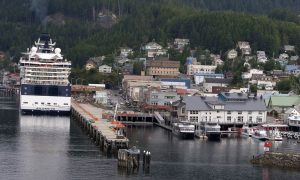 The southernmost city in Alaska is Ketchikan, a picturesque place and the first stop for many cruise ships heading north along the coast. Located at the foot of the mountain ranges, Ketchikan is famous for its many attractions. Visitors can visit the Totem Heritage Center, Tongass Historical Museum. Ketchikan is a center for outdoor recreation, where you can go fishing for salmon, hiking through the Tongass National Forest, or crossing the rope through the crowns of trees. The cruise port of Ketchikan is an important infrastructure facility of the city, which is a popular tourist destination and annually receives over a million guests.
The southernmost city in Alaska is Ketchikan, a picturesque place and the first stop for many cruise ships heading north along the coast. Located at the foot of the mountain ranges, Ketchikan is famous for its many attractions. Visitors can visit the Totem Heritage Center, Tongass Historical Museum. Ketchikan is a center for outdoor recreation, where you can go fishing for salmon, hiking through the Tongass National Forest, or crossing the rope through the crowns of trees. The cruise port of Ketchikan is an important infrastructure facility of the city, which is a popular tourist destination and annually receives over a million guests.
Although Ketchikan is known as the “salmon capital of the world” and fishing plays an important role in the life of the local population, tourism is the most significant aspect of the city’s economy, and most visitors arrive on cruise ships.
- In total, the port of Ketchikan annually receives more than 460 cruise ships, during the summer months, 6 ships every day.
- The port has 4 berths, numbered in order from south to north, ranging in length from a few dozen to over a hundred meters.
Interesting: The port of Ketchikan has an excellent location – within walking distance there are shopping centers and streets, in addition, taxis, buses and other means of transport are easily accessible on the port territory, and you can also book a tour of local attractions.
Thing to do number 8: Go to the Resurrection Bay
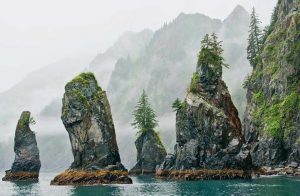 The Resurrection Bay is located near the town of Seward. It was discovered by the Russian fur merchant A. Baranov in the XVIII century and was named after Easter Sunday – this very day the ship hid from a storm in the bay. After Alaska became an American possession, the name was translated somewhat differently – Resurrection Bay. In the twentieth century, a fortified fort was built on one of the mountain peaks in the Bay of Resurrection. This was done in order to protect the coast from a possible invasion of the Japanese armed forces during World War II.
The Resurrection Bay is located near the town of Seward. It was discovered by the Russian fur merchant A. Baranov in the XVIII century and was named after Easter Sunday – this very day the ship hid from a storm in the bay. After Alaska became an American possession, the name was translated somewhat differently – Resurrection Bay. In the twentieth century, a fortified fort was built on one of the mountain peaks in the Bay of Resurrection. This was done in order to protect the coast from a possible invasion of the Japanese armed forces during World War II.
- The main feature of the bay is that the water here does not freeze even in winter, which makes it very convenient for studying marine flora and fauna.
- Here a research center successfully functions, the main task of which is not only conducting research and observations, but also accompanying tourist groups.
- Visitors can witness scientific discoveries, participate in the observation of dead ends, salmon, seals and sea lions in their natural habitat.
Interesting: You can swim in a canoe in the bay or stay in a campsite for fishermen and go out with them to catch halibut.
Thing to do number 9: Have a Look at the Great Landscapes of the Kobuk Valley
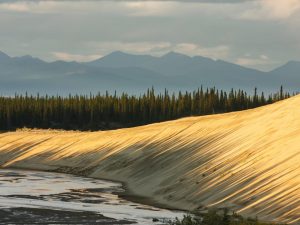 Kobuk Valley is the only place on earth where temperature rises up to 38 ° C, despite the fact that the entire territory of the valley is located above the Arctic Circle. Surprisingly, here, where the permafrost should begin, or at least the tundra, there are sand dunes with a height of over one hundred meters.
Kobuk Valley is the only place on earth where temperature rises up to 38 ° C, despite the fact that the entire territory of the valley is located above the Arctic Circle. Surprisingly, here, where the permafrost should begin, or at least the tundra, there are sand dunes with a height of over one hundred meters.
- About 13 years ago, the climate here was much milder and the whole plain was covered with green forests and meadows.
- There were mammoths and huge bison, mastodon, whose remains are still found in the ground. But the cooling that began to cause an increase in the level of the ocean, causing the continent to be flooded.
- When the water receded, only a bare plain remained, on which amazing dunes formed over time.
Interesting: Kobuk Valley is one of the most obscure parks in the country. Despite the numerous attractions and amazing natural landscapes, getting here is not as easy as ABC. But it is worth it. So, if you have an opportunity to come here, you won’t reject.
Thing to do number 10: Try your luck looking for gold on the banks of Nome
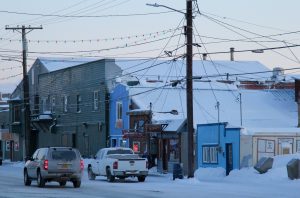 Alaska is the famous land of the gold rush. It is here that the famous river Nome flows into the Bering Sea, on the banks of which precious metal is mined.
Alaska is the famous land of the gold rush. It is here that the famous river Nome flows into the Bering Sea, on the banks of which precious metal is mined.
- The first gram of gold was discovered here by chance in 1898. This happened when three men were walking along the shore, and one of them allegedly came across a stone sticking out of the sand, which turned out to be a big gold nugget.
- For many years, people have learned to extract valuable metal in various sophisticated ways.
- After it turned out that the deposits are located not only on the shore, but also on the bottom of the river, the miners began to engage in dredging, hoping to stumble upon gold bars. People armed with shovels and diligently digging day and night – this is quite common in these places.
- For the extraction of small fractions of gold, people use special bowls for washing, in which a fine sieve is installed.
Interesting: There are no restrictions on the extraction of valuable metal on the coastal territory of Nome, there is free entrance to the beach, so thousands of people strive to get here every year with the hope of becoming fabulously rich.
Back